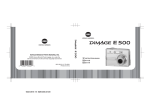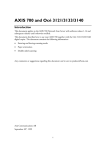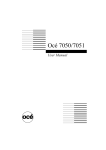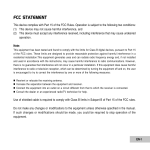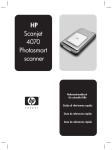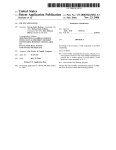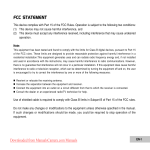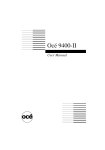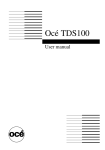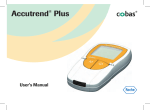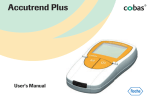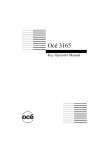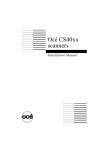Download Océ 7055/7056
Transcript
Océ 7055/7056 n User Manual Océ-Technologies B.V. This manual contains a description regarding the Océ 7055/7056 system and a detailed explanation about the plot functions. The introduction (chapter 1) contains a general description of the working methods for using the copier and it is recommended that you read at least this chapter. Overview of copier parts on the covers To assist you in finding parts of the copier/printer and the functions on the operating panel quickly, an illustration of the Océ 7055/7056 is presented on the inside front cover and of the operating panel on the inside back cover, both of which can be folded out. Safety information This manual contains the following safety information: ■ Appendix B lists ‘Instructions for safe use’. You are advised to read this information before you start to actually use the copier. Technical safety information such as safety data sheets can also be found in appendix B. ■ Where applicable, cautions and warnings are used throughout this manual to draw your attention to safety precautions to be taken.For more information on the notation conventions used in this manual, refer to Appendix C. Copyright Océ-Technologies B.V. Venlo, The Netherlands © 1998 All rights reserved. No part of this work may be reproduced, copied, adapted, or transmitted in any form or by any means without written permission from Océ. Océ-Technologies B.V. makes no representation or warranties with respect to the contents hereof and specifically disclaims any implied warranties of merchantability or fitness for any particular purpose. Further, Océ-Technologies B.V. reserves the right to revise this publication and to make changes from time to time in the content hereof without obligation to notify any person of such revision or changes. Code number 7114124 Edition 2.0 GB Contents Chapter 1 Introduction The Océ 7055/7056 6 The operating panel 7 Stand-by mode 7 Buttons and functions 7 Display 8 Switching on/off 9 Chapter 2 Copy jobs Introduction 12 Making copies 13 Special settings 19 Exposure setting 19 Trailing edge and leading edge 20 Making a test strip 22 Chapter 3 Materials Inserting a new copy material roll 24 Programming roll specifications 31 Adding toner 32 Cleaning the transparent platen 35 Chapter 4 Solving problems Introduction 38 Operator recoverable errors 39 Machine errors 40 Clearing original jams 41 Clearing paper jams 42 Contents 3 Appendix A Overview and Tables Standard settings 46 Standard operating mode 47 Product specifications 48 Roomtemperature (T) and Relative Humidity (RH) 48 Originals that can be used 49 Copy material that can be used 50 Appendix B Safety information Instructions for safe use 54 Mains core colours 56 Safety data sheets 57 Safety data sheets Océ 7055/7056. 58 Safety data sheet Océ OPC Drum 59 Safety data sheet Océ B1 Toner 61 Safety data sheet Océ Cleaner A 63 Safety data sheet Océ Developer 65 EPA ENERGY STAR® 67 Appendix C Miscellaneous Notation conventions 70 Reader’s comment sheet 71 Addresses of local Océ organisations 73 Index 75 4 Océ 7055/7056 User Manual Océ 7055/7056 User Manual Chapter 1 Introduction This chapter contains a general description of the Océ 7055/7056 and how to get the copier ready to copy. 5 The Océ 7055/7056 The Océ 7055/7056 is a copier for large documents (e.g. architectural or engineering drawings). The machine is easy to use and makes copies on paper, transparent, vellum or polyester film with the quality and reliability that one might expect from Océ. The Océ 7055/7056 has, besides a copy feed table for manual copy material input, an automatic copy material input mechanism. The Océ 7055 has only one copy material roll for automatic input whereas the Océ 7056 has two rolls. 6 Océ 7055/7056 User Manual The operating panel Stand-by mode The operating panel (see the illustration on inside back cover) on the Océ 7055/7056 is easy to use and specially designed to carry out copy jobs. After switching on, (see page 9), the machine is always ready for operation: the display shows blinking LEDs. In this state, the operating panel is in stand-by mode. The operating panel activates in the following situations: ■ ■ ■ ■ you feed an original you feed a copy material a button on the operating panel is pressed a roll unit is opened. Note: If you do not work with the operating panel for more than 2 minutes, it returns automatically to stand-by mode. The Océ 7055/7056, however, remains always for operation. Buttons and functions Start button The copy process starts with the current settings. Stop button The stop button stops the current copy process immediately without finishing the current job. The original and the copy material remain in the copier. Exposure level You modify the exposure level with the ‘lighter’ and ‘darker’ buttons. The exposure level can be changed at all times. Copy material input button With this button you choose the input of the copy material. Possible input selections are manual feed, roll 1 or roll 2. Copy material selection button If you have selected manual feed, you use this button to select the copy material. Your selection, paper or film, influences the fusing temperature. All materials, except for film, should be copied in the ‘paper’ setting. You also use this button to program the copy material on a roll. Introduction 7 Copy quantity selection button Press these buttons to increase or decrease the number of copies. The copy quantity can be changed at all times. Correction button Resets the copy quantity counter to ‘1’. By pressing the correction button twice, all settings will reset to the standard settings (see ‘Standard settings’ on page 46). Trailing edge With this button you add or remove a filing strip at the trailing edge varying between +40 to -100 mm in steps of 5 mm. Leading edge With this button, you add or remove a filing strip at the leading edge varying between +100 to -100 mm in steps of 5 mm. Operating mode button This button toggles between synchro cut mode and standard mode. In synchro cut mode, the copy is cut at the length of the original. In standard mode, the copy is cut at a standard length. Display Depending on the mode you are working in, you have to interpret the figures shown on the display in a different way: ■ ■ ■ ■ ■ ■ ■ 8 In stand-by mode, the display shows blinking LEDs. In manual feed mode, the display shows the length of the original in mm. When you select roll 1 (or roll 2 for the Océ 7056) in automatic feed mode, the display shows the width of the roll. The width of the roll and the kind of material should be configured when a new roll is inserted. When a roll unit is opened, the display flashes. In this mode you can program the width of the roll and the kind of copy material of the roll. In standard operating mode, the display shows the standard length that you select with the selections buttons. The pair of symbols on the display and next the operating mode indicator are lighted. In synchro-cut mode, you can see the values of the trailing and leading symbols on the display and next to the edge edges.The pair of adjustments indicators identify which values are displayed. Océ 7055/7056 User Manual Switching on/off After switching on the machine is ready for operation. The display shows blinking LEDs. In this state, the operating panel is in stand-by mode. After you have switched on the machine, there is no need to switch it off after each copy job. You can leave the machine switched on for the rest of the day since it uses less than 15 W in this mode. At all times, the Océ 7055/7056 is ready for operation. If the machine has been inactive for more than 2 minutes, the operating panel returns automatically to the stand-by mode. The operating panel activates in the following situations: ■ ■ ■ ■ ▼ you feed an original you feed a copy material a button on the operating panel is pressed a roll unit is opened. Switching on 1 Set the on/off switch at the rear of the machine, to position ‘1’ (see figure 1). If the mains is connected correctly, the green switch will light up. [1] On/off switch Note: The machine is immediately ready for use. ▼ Switching off 1 Set the on/off switch at the rear of the machine, to position ‘0’ (see figure 1). Introduction 9 10 Océ 7055/7056 User Manual Océ 7055/7056 User Manual Chapter 2 Copy jobs Making copies and special settings 11 Introduction With the Océ 7055/7056, you can make copies on paper, transparent, vellum or polyester film. You can select between manual feed and automatic feed by pressing the copy material input button. When automatic feed is selected, the copy material is taken from the selected roll. The copy material is then cut. The length of the copy depends on the operating mode you have selected. The operating mode can be either synchro cut or standard. With the copy material selection button you can select the copy material. Pressing the button toggles between film and paper. You only have to use this button if you have selected manual feed. When using automatic feed, the copy material should be configured as a new roll is inserted. Note: Only use paper as is specified in ‘(see ‘Copy material that can be used’ on page 50). Avoid storing paper in rooms where temperature and humidity are high (see ‘Roomtemperature (T) and Relative Humidity (RH)’ on page 48). Also, avoid dust and direct sunlight. Wrap unused paper in plastic to prevent it absorbing moisture. 12 Océ 7055/7056 User Manual Making copies When you use the manual feed option, you can always feed the original or the copy material. The copying process only starts after pressing the ‘start’ button. Before pressing the ‘start’ button, you can control and change the settings. When you use the automatic feed option, you can always feed the original. The copying process only starts after pressing the ‘start’ button. Before pressing the ‘start’ button, you can control and change the settings. Note: After 2 minutes of idleness, the operator panel returns to the ready mode. When you wait more than 2 minutes between two operations, you have to restart the procedure. ▼ Making copies using the automatic feed option 1 Press the copy material input button until the LED that corresponds with the roll of your choice lights up. The display shows the width of the selected roll. Note: The copy material should be configured as a new roll is inserted. Hence, as you select a roll, the copy material selection is automatically updated. 2 Select the desired number of copies by pressing the ‘+’ or ‘-’ button on the operating panel see figure 2. Note: Changing the copy quantity can be done at all times. When you make a mistake you simply press the correction button to correct the copy quantity. add toner paperpath C correction start - + stop [2] Setting more than one copy using the ‘+’ or ‘-’ button Copy jobs 13 3 Press the operating mode button to toggle between synchro cut mode and standard mode. Synchro cut mode is selected by default. ■ ■ In synchro cut mode, the copy is cut at the length of the original. In standard mode, the copy is cut at a standard length. You select the standard length with the selection buttons. For an overview of the possible standard lengths, refer . 4 Feed the original centrally and face down into the original feed table in accordance with the guidelines see figure 3. [3] Feeding an original Note: The original is aligned in the nip of the rollers. By inserting the material with an amount of slack, the leading edge is aligned in the nip. A delay between insertion of the material and the start of the transport ensures proper alignment. The original is transported to the rear of the machine. Attention: Strongly curled originals have to be fed in carefully. In certain circumstances the copier can pull the original in. Note: Minimum length that the machine can cut is 420 mm. 14 Océ 7055/7056 User Manual 5 Press the start button. The copies are made and cut at the appropriate length. After the job is completed the copy counter is set to 0. If you want to make more copies of the same original, you don’t have to feed the original again as long as you haven’t pulled it from the original feed table. Control the settings and press the ‘start’ button again: the original is transported back into the rear of the machine to prepare for a next batch of copies, and the counter isincreased to 1. By pulling out the original the counter will be set to 1. ▼ Making copies using the manual feed option 1 Press the copy material input button until the manual feed LED lights up or insert a sheet of copy material in the manual copy material feed table. 2 Press the copy material selection button to toggle between paper (paper, vellum,...) or film. Attention: Select the appropriate copy material to avoid flawed copies. All materials (except for film) should be copied with the copy material selection set to ‘paper’. Only select the setting ‘film’ if you make copies on polyester film 3. 3 Select the desired number of copies by pressing the ‘+’ or ‘-’ button on the operating panel (see figure 4 on page 16). Copy jobs 15 Note: Changing the copy quantity can be done at all times. When you make a mistake you simply press the correction button to correct the copy quantity. 2477 [4] Setting more than one copy using the ‘+’ or ‘-’ button 4 Feed the original centrally and face down into the original feed table in accordance with the guidelines (see figure 5 on page 17). Note: The original is aligned in the nip of the rollers. By inserting the material with an amount of slack, the leading edge is aligned in the nip. A delay between insertion of the material and the start of the transport ensures proper alignment. The original is transported to the rear of the machine and the display shows the length of the original. 16 Océ 7055/7056 User Manual Attention: Strongly curled originals have to be fed in carefully. In certain circumstances the copier can pull the original in. [5] Feeding an original Note: Minimum length of the copy material is 420 mm. 5 Feed a sheet of copy material, in line with the original, into the copy feed table in accordance with the guidelines (see figure 6 on page 18) . Note: The copy material is aligned in the nip of the rollers. By inserting the material with an amount of slack, the leading edge is aligned in the nip. A delay between insertion of the material and the start of the transport ensures proper alignment. Copy jobs 17 Attention: If sheets of copy material are curled, feed them with the curl facing down. 2477 [6] Feeding the copy materialmakemore copies of 6 Press the start button. The copy will now be made and the copy quantity counter decreases by one. After the job is completed the copy counter is set to 0. If you want to make more copies of the same original, you don’t have to feed the original again as long as you haven’t pulled it from the original feed table. Control the settings and press the ‘start’ button again: the original is transported back into the rear of the machine to prepare for a next batch of copies, and the counter is increased to 1. By pulling out the original the counter will be set to 1. 18 Océ 7055/7056 User Manual Special settings Exposure setting When copying extremely light or dark originals, or originals with unequal background density, the result may not meet your requirements (e.g. too much background). In such cases you can adjust the exposure level. In the default setting the exposure level indicator is in the neutral position see figure 7. 4 manual feed 2 roll 2 film roll 1 paper 0 lighter 2 4 darker [7] Exposure setting ▼ Exposure setting 1 If the copy is too dark, you can modify the exposure level using the ‘lighter’ button. 2 If the copy is too light, you can modify the exposure level using the ‘darker’ button. Copy jobs 19 Trailing edge and leading edge Assume that you are working in automatic feed mode and your original has a filing strip. If you don’t want the filing strip to show on the copy, it is possible to create an edge. Make sure that the filing strip is at the trailing edge of the original see figure 8. The adjustment steps are indicated on the operating panel, expressed in millimetres. The opposite of a trailing edge is called leading edge. - 40 [8] Example of adjusting the trailing edge 20 Océ 7055/7056 User Manual ▼ Adjusting the edge 1 Press the edge selection button to toggle between leading edge and trailing edge (see figure 9 for an example). The length display shows the length of the currently selected edge. standard synchro cut + trailing edge leading edge [9] Trailing edge buttons 2 Press the edge adjustment buttons to change the size of the edge. Pressing the ‘-’ button decreases the size of the edge. Pressing the ‘+’ button increases the edge. Attention: Be aware that decreasing the edges too much may result in a loss of information. Copy jobs 21 Making a test strip In some cases you want to check the exposure settings and the quality without wasting a complete copy. If this is the case, you can make a test strip. A small part of the original is copied on a strip. This test strip is cut the minimum length of 420 mm. ▼ Making a test strip 1 Press the operating mode button and select the standard operating mode. The symbols in the display and next to the standard operating mode indicator light up. 2 Press the selection buttons until the display shows ‘tESt’. standard synchro cut + trailing edge leading edge [10] Trailing edge buttons 3 Press the start button. The test strip is copied and cut. 22 Océ 7055/7056 User Manual Océ 7055/7056 User Manual Chapter 3 Materials This chapter describes how to insert a new copy material roll, how to add toner and how to clean the transparent platen. 23 Inserting a new copy material roll If the paper path indicator flashes and the display shows error message E5, then you have to insert a new copy material roll. ▼ Inserting a new material roll in the drawer section (roll 1) 1 Pull the drawer section open by using the two catches. (see figure 11) 248 8 [11] Opening the drawer section 24 Océ 7055/7056 User Manual 2 Remove the roll holder from the drawer. (see figure 12) 2488 248 6 [12] Removing the roll holder from the drawer section 3 Remove the cardboard core from the roll holder. 4 Place the new roll of copy material on a table. Materials 25 5 Slide the roll holder in the new roll of copy material while pressing the knob. (see figure 13) 248 5 [13] Pressing the knob 6 Align the copy material roll with the appropriate lines on the roll holder while pressing the knob. 26 Océ 7055/7056 User Manual 7 Reposition the roll holder with the copy material in the drawer. (see figure 14) 249 0 [14] Repositioning the roll 8 Feed the copy material as is shown in 15 on page 27. Use your thumbs to feed the copy material with the rollers. The arrow on the sticker indicates how far you have to feed the copy material. . copy material [15] Feeding copy material 9 If you have inserted a roll with an another copy material or with different width, you have to program this (see ‘Programming roll specifications’ on page 31). Materials 27 10 Close the drawer. ▼ Inserting a new material roll in the flap section (roll 2) Note: This section is only intended for the Océ 7056. 1 Pull the flap section open by using the two catches. (see figure 16) 248 8 [16] Opening the flap section 28 Océ 7055/7056 User Manual 2 Remove the roll holder. (see figure 17) 87 24 [17] Removing the tube from the flap section 3 Remove the cardboard core from the roll holder. 4 Place a new roll of copy material on a table. 2488 5 Slide the roll holder in the roll of copy material while pressing the knob. (see figure 13 on page 26) 249 0 [18] Pressing the knob 6 Align the copy material roll with the appropriate lines on the roll holder. Materials 29 7 Reposition the roll holder with the copy material roll in the drawer and feed the copy material (see figure 14 on page 27). Use your thumbs to feed the copy material with the rollers. The arrow on the sticker indicates how far you have to feed the copy material. copy material 24 89 [19] Repositioning the roll 2485 8 If you have inserted a roll with an another copy material or with a different width, you have to program this(see ‘Programming roll specifications’ on page 31). 9 Close the flap. 30 Océ 7055/7056 User Manual Programming roll specifications If you have inserted a new roll with another copy material or with a different width, you have to program the Océ 7055/7056. Programming the roll specifications implies that you instruct the machine of the specifications of the copy material on the rolls. These specifications are the following: ■ ■ ▼ paper or film width of the copy material. Programming roll specifications 1 Open the roll unit. The display flashes indicating that you are now in programming mode. 2 If necessary, insert a new copy material roll. (see ‘Inserting a new copy material roll’ on page 24) 3 Press the copy material input button to toggle between roll 1 or roll 2. Select the roll that you want to program the specifications for. 4 Press the copy material selection button to toggle between paper (paper, vellum,...) or film. Attention: Select the appropriate copy material to avoid flawed copies. All materials (except for film) should be copied with the copy material selection set to ‘paper’. Only select the setting ‘film’ if you make copies on polyester film 5 Close the roll unit. The specifications of the roll are now programmed. Materials 31 Adding toner If the toner level is low, the ‘add toner’ indicator starts flashing. You can finish your job. Then add toner. Attention: If you ignore this symbol, copy quality will diminish. ▼ Adding toner Attention: Only use B1 toner. 1 Switch off the copier. 2 Unscrew the knurled nut at the left hand side of the machine and open the cover (see figure 20). [20] Unscrewing knurled nut and opening the cover 3 Shake the toner bottle thoroughly and open the bottle. 32 Océ 7055/7056 User Manual 4 Screw in the bottle clockwise in a slanted position (see figure 21). [21] Screwing in the bottle 5 Move the toner bottle to a vertical position ( see figure 21 and 22 ). [22] Adding toner 6 When the toner bottle is empty return the bottle to the original position. 7 Unscrew the toner bottle anti clockwise. Materials 33 ▼ Replacing the waste toner bag 8 Pull the waste toner bag from the holder and place the cap provided on the bag (see figure 23). [23] Replacing the waste toner bag 9 Slide a new waste toner bag over the holder. 10 Close the cover and tighten the knurled nut. 11 Switch on the copier. 34 Océ 7055/7056 User Manual Cleaning the transparent platen If the transparent platen is dirty or static it should be cleaned to ensure top quality copies. At the same time you can clean the white pressure platen Attention: To achieve the best results, we recommend the use of Océ cleaner ‘A’. (Codenr. 1068117; Cleaner kit). ▼ Cleaning the transparent platen and the pressure platen 1 Switch off the copier. 2 Open the top cover by pulling it towards you and raising the cover (see figure 24). 2469 [24] Opening the top cover Materials 35 3 Clean the transparent platen and the white pressure platen with a soft cloth moistened with a small quantity “Cleaner A”. For safety information see the safety data sheet in Appendix B. [25] Cleaning the transparent platen and the white pressure platen Attention: Make sure not to damage the actuator 25 on page 36, located in the middle of the transparent platen. 4 Close the top cover and push it back until you hear a click. 5 Switch on the copier.9 36 Océ 7055/7056 User Manual Océ 7055/7056 User Manual Chapter 4 Solving problems This chapter contains information on how to proceed incase a problem arises. 37 Introduction This chapter documents problems that may occur with the Océ 7055/7056 and how to solve them. When an error occurs, the operating panel informs you about the nature of the problem. ■ ■ ■ 38 if the paper path indicator flashes, a paper jam has occurred (see ‘Clearing original jams’ on page 41)and (see ‘Clearing paper jams’ on page 42). if the display shows an error code, i.e. between E0 and E5, an operator recoverable error has occurred. (see ‘Operator recoverable errors’ on page 39) if the display shows a flashing 4-digit error code, a machine error has occurred (see ‘Switch on the copier.’ on page 44). Océ 7055/7056 User Manual Operator recoverable errors When the copier detects an error, the copier stops immediately. The paper path indicator will lit and the length display shows an error code. The following explains the general procedure in case of an operator recoverable error ▼ General procedure for operator recoverable errors 1 2 3 4 5 Remove the original. Open the manual copy material feed table. Remove the copy material. Check the paper path. Close the manual copy material feed table. The following table gives an overview of possible causes and specific actions. Error messages Message E0 E1 E2 E3 Possible causes Specific actions ■ Copy material is removed dur-Contact the key operator. ing the copy process. ■ Stop button has been pressed during a copy process. ■ Original feed problem. Paper feed table is open. Close paper feed table. Copy material is too short Contact the key operator. ■ Initialisation error 1 Cut the paper manually with ■ Paper feed timing error a cutter. ■ Knife cut timing error. 2 Contact the key operator E4 Automatic copy material drawer 1 Close the drawer or flap opened during operation 2 Contact the service operator E5 Out of paper Solving problems 1 Insert a new paper roll. 2 check the paper path 39 Machine errors ▼ Solving a machine error 1 Switch off the copier and check the complete paper path (see page 41 and page 42). 2 Then switch it on again. If no error number is shown on the length display, you can continue copying. If the machine error maintains, then call the key operator. 40 Océ 7055/7056 User Manual Clearing original jams When during copying an original jam occurs, the paper path indicator will start flashing and the display shows the error message E0. ▼ Clearing an original jam 1 Switch off the copier. 2 First try to remove the jammed original by pulling it gently towards you with both hands. In case of a very fragile original: 3 Open the top cover by pulling it towards you and raising the cover (see figure 26). 2469 [26] Opening the top cover 4 Remove the original. 5 Close the top cover and push it back until you hear a click. 6 If there is copy material in the copier, clear copy path (see ‘Clearing paper jams’ on page 42). 7 Switch on the copier. Solving problems 41 Clearing paper jams When paper feeds incorrectly, the paper path indicator will flash. ▼ Clearing a paper jam in the copy material feed section 1 Switch off the copier. 2 Lower the copy feed table, using the two catches on the front underneath the copy feed table (see figure 27). 2473 [27] Lowering the copy feed table 3 Remove the jammed copy material. Attention: Pull the sheet of paper backwards carefully, the sheet might be unfused on some parts. Note: Check thoroughly that no scraps of material are left behind. 4 Close the copy feed table. 5 Switch on the copier. 42 Océ 7055/7056 User Manual If the paper jam can not be cleared by opening the copy feed table than open the fusing section by: 1 Switch off the copier. 2 Unscrew the knurled nut at the left hand side of the machine and open the cover (see figure 28). [28] Opening the left cover at the rear of the machine 3 Lift the green handle and open the fuser unit ( see figure 28 and 29 on page 43 ). Caution: If the copier has been used recently, the fuser may still be hot. 24 75 [29] Opening the fuser unit Solving problems 43 4 Remove the jammed copy material. Attention: Be careful! The toner is not fused. Note: Check thoroughly that no scraps of material are left behind. 5 Lift the green handle and close the fuser unit. 6 Close the left cover and screw the knurled nut. 7 Switch on the copier. 44 Océ 7055/7056 User Manual Océ 7055/7056 User Manual Appendix A Overview and Tables 45 Standard settings On delivery the Océ 7055/7056 is configured with a number of standard settings. Standard settings Océ 7055/7056 Exposure level Copy material Trailing edge Leading edge Copy quantity Copy material roll Operating mode 46 0 paper 0 mm 0 mm 1 1 synchro cut Océ 7055/7056 User Manual Standard operating mode When standard operating mode selected, the copy is cut at a pre-set standard length. Nine different settings are available by selecting standard operating mode and pressing the selection buttons. The following settings are possible: ■ ■ ■ ■ ■ ■ ■ ■ ■ 1189 mm 841 mm 594 mm 420 mm 1230 mm 880 mm 450 mm 420 mm tESt Overview and Tables 47 Product specifications For more information about product specifications refer to the Océ 7055/7056 safety data sheet in Appendix B. Product specifications Process Exposure Developing system Fixing system Warm-up time Scale Image width Copying speed Machine size Machine weight Dry indirect electrostatic Slit exposure with one fluorescent lamp and SLA Binary toner system Instant heating system none 1:1(+/- 0.5%) Max. 914 mm (36”) 3m/min 1352 x 1240 x 900 (wxdxh in mm) Océ 7055: 152 kg (copy material excluded) Océ 7056: 162 kg (copy material excluded) Roomtemperature (T) and Relative Humidity (RH) A: Machine specifications are applicable for the following conditions. B: Copy quality not guaranteed, no permanent machine damage. RV % 80 B 60 A 30 20 17 20 48 Océ 7055/7056 User Manual 27 30 T ˚C Originals that can be used Overview of originals Originals Width Length Length in retention Thickness Weight Minimum 210 mm (8.5”) 279 mm (10”) 1200 mm (48”) Maximum recommended 1000 mm (40”) 3000 mm (10”) ( max. 30 m) 0.05 mm 60 g/m2 1.5 mm 120 g/m2 (max. 210 g/m2) Mechanical conditions originals Curls > Ø 75mm without help of operator < Ø 75 mm with help of operator < Ø 50 mm in carrier sheet Paste ups Paste ups should be pasted 100% at all edges or in carrier sheet Filing strips May be present at all edges of the original. Maximum size of hole: Ø 36 mm Borders Punching holes, reinforcement borders and damages may require operator interventions or use of carrier sheets Folds Wrinkles and folds may be visible on the copy Overview and Tables 49 Copy material that can be used Océ copy machines and materials are matched for optimal quality and performance. It is therefore recommended to use only approved Océ materials in the Océ 7055/7056. A full list of Océ materials suited for use in the Océ 7055/7056, including plain paper, transparent paper, coloured papers and various polyester films is available from your Océ representative. The maximum length of the copy material is 175 m when you use 75 g/m2 copy material and 150 m in case of 110 g/m2 . The diameter of the roll holder equals 3 inch. Overview of copy material Copy material Plain paper Transparent paper Vellum Polyester film ECO papers Width Length Recommended 75 g/m2 110 g/m2 20 lbs 3.5 mil 75 g/m2 Minimum 297 mm 420 mm Maximum 914 mm any manegeable length Attention: Paper- and transparentmaterial is sensitive to high humidity. To ensure optimal copy quality it is advised to keep the copy materials in the packaging specially overnight. Caution: Materials which are metalbased or conductive are not designed to use in this machine and may result in injury to the operator. Attention: If sheets of copy material are curled, feed them in with the curl facing down, otherwise you will damage the drum. 50 Océ 7055/7056 User Manual Compatibility review media Materials Opaque paper Opaque paper ECO papers Weight 75 g/m2 Judgement good Remark 110 g/m2 acceptable Guaranteed upto 50% RH 75 g/m2 Transparent paper 80/85 g/m2 90/95 g/m2 110/115 g/m2 3.5 mil 4 mil good/acceptable acceptable acceptable good good acceptable 3.5 mil 20 lbs 16 lbs 135 g/m2 good good acceptable acceptable 90 g/m2 80 g/m2 acceptable acceptable Polyester film Clear polyester film Contrast film Vellum Vellum Contrast paper Fluor paper Pastel paper Good: Acceptable: Not suitable: Overview and Tables Guaranteed upto 50% RH means fully recommended means acceptable for limited performance means not suitable at all 51 52 Océ 7055/7056 User Manual Océ 7055/7056 User Manual Appendix B Safety information 53 Instructions for safe use Océ designed products have been tested in accordance with the strictest international safety standards. To help assure safe working with these products it is important that you observe the following safety rules: Maintenance ■ ■ ■ ■ ■ ■ Do not remove any screws from fixed panels. Do not carry out maintenance activities except for the parts and maintenance materials mentioned in this manual. Do not place any liquids on the machine. Use maintenance materials or other materials for their original purpose only. Keep maintenance materials away from children. Do not mix cleaning fluids or other substances. To avoid the risk of introducing hazards, all modifications to Océ equipment are strictly reserved to properly qualified and trained service technicians. Connection ■ ■ ■ ■ ■ ■ 54 If for some reason you have to move the machine yourself, please make sure that the mains power point has the right fuse capacity. See the Océ 7055/7056 safety data sheet in this appendix for information about maximum current. Do not bridge any mechanical or electrical circuit breakers. Do not use an extension lead to connect the machine. This equipment has not been designed for connection to an IT power system. (An IT power system is a voltage network in which the neutral wire is not connected to earth). For equipment connected via a wall socket: locate the machine close to a wall socket that is easily accessible. For equipment connected via a fixed connection to the electricity grid: the disconnect device in the fixed connection should be easily accessible. Océ 7055/7056 User Manual Surroundings ■ ■ ■ ■ ■ Do not block the ventilation openings of the machine. Ensure that the machine is placed on a level, horizontal surface of sufficient strength. See the Océ 7055/7056 safety data sheet in this appendix for information about the weight of the equipment. Ensure there is sufficient space around the machine. This facilitates reloading materials as well as maintenance. Do not place the machine in rooms which are subject to excessive vibration. Do not place the machine in rooms which are too small and insufficiently ventilated. See the Océ 7055/7056 safety data sheet in this appendix for information about space and ventilation requirements. General ■ ■ Always use materials recommended by Océ and developed for this Océ machine. Materials not approved by Océ may result in faults in your machine. Do not use the machine when it is emitting unusual sounds. Remove the plug from the power socket or switch off the fixed connection to the electricity grid and contact Customer Service. Safety information 55 Mains core colours As the colours of the cores in the mains lead of this equipment may not correspond with the coloured markings identifying the terminals in your plug, proceed as follows: ■ ■ ■ 56 The core which is coloured green and yellow must be connected to the terminal in the plug which is marked with the letter E or by the earth symbol, coloured green and yellow. The core which is coloured blue must be connected to the terminal which is marked with the letter N or coloured black. The core which is coloured brown must be connected to the terminal which is marked with the letter L or coloured red. Océ 7055/7056 User Manual Safety data sheets The disclaimer below is valid for all safety data sheets in this manual. For questions about Océ products regarding health, safety and environment, please contact your Océ organisation; you can find the address in the last appendix of this manual. Disclaimer The safety data sheets in this manual have been compiled to the best of our knowledge as a compact guide to safe handling of this product. We reserve the right to revise safety data sheets as new information becomes available. It is the user’s responsibility to determine the suitability of this information for the adoption of safety precautions as may be necessary and to contact the company to make sure that the sheet is the latest one issued. If and in so far as limitation of liability is permitted under the applicable laws, we do not accept liability for any inaccuracy that may occur in this information. Safety information 57 Safety data sheets Océ 7055/7056. PRODUCT SAFETY DATA SHEET Océ-(UK), Ltd E-664-c-UK Number November 1997 Date United Kingdom Model Océ 7055/7056 Description Electrostatic large format copier, instant copying, desk-top or console model, plain paper, organic photoconductive drum, powder toner. 3 m/min Max. process speed Dimensions Width Depth Height Weight Voltage Frequency Current - rated Current - max Power consumption Power consumption, stand by EPA Energy Star® * Power consumption, auto off Mains connection Safety class Protection class 7055 1352 918 1251 152 mm mm mm kg 230 50 7,5 10 1500 14 V Hz A A W at continuous operation W mm mm mm kg 14 W; Default time 2 minutes Cable with plug I (IEC 536) Protective earth connection IP 20 (IEC 529) Stand by 0 dB(A) Sound pressure level (at operator position) 7056 1352 918 1251 162 In operation main body 58 dB(A) impulse ∆ Li = 3 dB(A) 0 dB(A) main body 65 dB(A) Complies with Directive 89/336/EEC Below the Threshold Limit Values for UV, Visible and IR radiation (TLV list of ACGIH) Stand by 14 W, 1500 W at continuous operation 0,04 mg/min at continuous operation Recommendation: min. 25 m3 Recommendation: min. 12,5 m3/h (natural ventilation) With a room volume and ventilation as recommended and a daily volume of 100 m (much more than average)theusesimulationatrandomoperationgivesthefollowingozoneconcentrations: - Time weighted average 0,002 mg/m3 (0,001 ppm) - Peak 0,008 mg/m3 (0,004 ppm) Sound power level Radio interference Radiation Heat emission Ozone emission Room volume Room ventilation Use simulation at random operation Threshold Limit Value/Occupational Exposure Limit (Time Weighted Average) for ozone Odour Perception Limit for ozone (0,1 ppm) (0,02 ppm) Océ OPC Drum (Océ Safety Data Sheet E-192) Océ B1 Toner (Océ Safety Data Sheet E-180) Océ D1 Developer (Océ Safety Data Sheet E-181) Océ Copying Materials. This apparatus is suitable for processing recycling paper which complies with the requirements of ENV 12281. Consumables Additional safety information CE-Compliance 0,2 mg/m3 0,04 mg/m3 The ozone filter does not have to be replaced to keep the ozone concentration in the workplace below 0,04 mg/m3 (i.e. the life of the filter equals that of the apparatus). Approved according to Low Voltage Directive 73/23/EEC Approved according to EMC Directive 89/336/EEC EPA Copier Compliance Copyright © 1995 Océ-Technologies B.V., Venlo, NL The content of this safety data sheet is subject to the disclaimer on page 57 of this manual. 58 Océ 7055/7056 User Manual Safety data sheet Océ OPC Drum MATERIAL SAFETY DATA SHEET Number Date Page (93/112/EEC and ISO 11014-1) E-192-b-UK July 1997 1 of 2 Océ OPC Drum Part No. 2912571 1. Product and company identification Product name Packing Company Address Telephone Telefax Océ OPC Drum Part No. 2912571 (for Océ 7050 family) Cardboard box Océ (UK) Ltd. Langston Road, Loughton, Essex IG10 3SL 0181-508 5544 (contact product safety coordinator) 0181-508 6689 2. Composition / information on ingredients Ingredients CAS No. Aluminium Resins Pigments 7429-90-5 Classification Weight % >99 <1 <1 3. Hazards identification To our knowledge this product presents no health hazard in normal use. 4. First aid measures Eyes contact Skin contact Inhalation Ingestion Not Applicable(=N.A.) N.A. N.A. N.A. For any medical advice take along this material safety data sheet. 5. Fire fighting measures Flash point (o C) Explosion limits (dust explosion) Ignition temperature (o C) Extinguishing media Special fire fighting precautions Hazardous products of decomposition N.A. (=Not Applicable) LEL N.A. UEL N.A N.A. Dry chemical, carbon dioxide, water spray (fog), foam N.A. N.A. 6. Accidental release measures N.A. 7. Handling and storage No special technical measures for storage. 8. Exposure controls / personal protection No special technical measures. No personal protective equipment needed. No special work hygiene practices needed. continued on the next page Safety information 59 MATERIAL SAFETY DATA SHEET (93/112/EEC and ISO 11014-1) Number Date Page E-192-b-UK July 1997 2 of 2 Océ OPC Drum Part No. 2912571 9. Physical and chemical properties Appearance and odour Boiling point (o C) Vapour density (air = 1) Solubility in water Vapour pressure Other characteristics brown odourless drum N.A N.A. Insoluble N.A. N.A. Density (g/cm3) Melting point (o C) Evaporation rate (butyl acetate =1) % Volatile pH (solution) 2,7 N.A. N.A. 0 N.A. 10. Stability and reactivity Thermal decomposition Hazardous decomposition products Hazardous reaction None at intended use None at intended use None at intended use 11. Toxicological information Inhalation Skin Eyes Ingestion Mutagenicity N.A. No adverse health effects are expected. (Based on toxicological literature on the ingredients of this product) N.A. N.A. No mutagenicity detected in Ames test. None of the ingredients is listed as mutagenic or carcinogenic. 12. Ecological information This product is not biodegradable. The ingredients are not classified as ecologically hazardous. No adverse environmental effects are expected. 13. Disposal considerations The drum will be returned to Océ for re-use. 14. Transport information This product is not classified as a dangerous substance according to the international transport regulations. 15. Regulatory information This product is an article and contains no dangerous substances. Therefore, indications of special risks or safety advice on the packing are not prescribed for this product. 16. Other information Use: photoconductor for copiers. Revision of E-192-a-UK dated December 1994. Modification:none . Copyright © 1994 Océ-Technologies B.V. Venlo, NL The content of this safety data sheet is subject to the disclaimer on page 57 of this manual. 60 Océ 7055/7056 User Manual Safety data sheet Océ B1 Toner MATERIAL SAFETY DATA SHEET Number Date Page (93/112/EEC and ISO 11014-1) E-180-b-UK July 1997 1 of 2 Océ B1 Toner 1. Product and company identification Product name Packing Company Address Telephone Telefax Océ B1 Toner Polyethylene bottle, contents 0,4 kg/0.89 lb Océ (UK) Ltd. Langston Road, Loughton, Essex IG10 3SL 0181-508 5544 (contact product safety coordinator) 0181-508 6689 2. Composition / information on ingredients Ingredients CAS No. Polyester resin Phenoxy resin Carbon black Dye Pigments 170831-75-1 PMN P-95-461 1333-86-4 Classification Weight % 50-100 25-50 5-10 1-5 <1 3. Hazards identification In a toner dust cloud the formation of an explosive dust-air mixture is possible. Toner dust may cause discomfort for the eyes and respiratory tract, in the same manner as inert nuisance dust. To our knowledge, with due observance of the recommended exposure limit and of normal hygiene this product presents no health hazard in normal use. 4. First aid measures Eyes contact Skin contact Inhalation Ingestion Rinse with plenty of water. Wash with cold water and soap. Clean nose, mouth, throat. Cough up. Fresh air. Rinse mouth with water. If large quantity swallowed seek medical advice. For any medical advice take along this material safety data sheet. 5. Fire fighting measures Flash point (o C) Explosion limits (dust explosion) Ignition temperature (o C) Extinguishing media Special fire fighting precautions Hazardous products of decomposition N.A. (=Not Applicable) LEL approx. 60 g/m3 . UEL U (= unknown) Approx. 500 Dry chemical, carbon dioxide, water spray (fog), foam N.A. N.A. 6. Accidental release measures Spills can be cleaned with a vacuum cleaner or a damp rag. Do not use warm water, because this makes the powder soft and sticky. 7. Handling and storage Keep bottle tightly closed to prevent dust formation. Handle carefully. Avoid breathing dust. No special technical measures for storage. 8. Exposure controls / personal protection No special technical measures. No personal protective equipment needed. Industrial hygiene: after skin contact wash with cold water and soap. Threshold Limit Value for nuisance dust: 10 mg/m3. Threshold Limit Value for carbon black: 3,5 mg/m3. continued on the next page Safety information 61 MATERIAL SAFETY DATA SHEET (93/112/EEC and ISO 11014-1) Number Date Page E-180-b-UK July 1997 2 of 2 Océ B1 Toner 9. Physical and chemical properties Appearance and odour Boiling point (o C) Vapour density (air = 1) Solubility in water Vapour pressure Other characteristics Black powder, faint odour. N.A N.A. Insoluble N.A. N.A. Bulk density (kg/m3) Softening point (o C) Evaporation rate (butyl acetate = 1) % Volatile pH (solution) Approx. 1250 Approx. 50 N.A. 0 N.A. 10. Stability and reactivity Thermal decomposition Hazardous decomposition products Hazardous reaction Above approx. 450 oC None at intended use None at intended use 11. Toxicological information Inhalation Skin Eyes Ingestion Mutagenicity * At high concentration in air the powder may cause discomfort of upper respiratory system. * No adverse health effects are expected. * Dust may cause discomfort in the same manner as nuisance dust. * Considered relatively harmless. No mutagenicity detected in Ames test. * These statements are based on toxicological literature on the ingredients of this product and test results of similar products. 12. Ecological information This product is not biodegradable. The ingredients are not classified as ecologically hazardous. No adverse environmental effects are expected. 13. Disposal considerations Pack waste dustproof to prevent dusting. With due observance of local laws and regulations, dispose of by burial in a sanitary landfill or incineration. Do not throw in open fire, in order to prevent the risk of a dust explosion. 14. Transport information This product is not classified as a dangerous substance according to the international transport regulations. 15. Regulatory information This product is not classified as a dangerous preparation according to the European Directives 67/548/EEC and 88/379/EEC for the classification, packaging and labelling of dangerous substances and preparations. Therefore, indications of special risks or safety advice on the packing are not prescribed for this product. 16. Other information Use: ink powder for copiers. Room ventilation: see operator manual or safety data sheet for the copier. Revision of E-180-a-UK dated November 1994. Modifications: Statement of mutagenicity, softening point and information on ingredients changed. Copyright © 1994 Océ-Technologies B.V. Venlo, NL The content of this safety data sheet is subject to the disclaimer on page 57 of this manual. 62 Océ 7055/7056 User Manual Safety data sheet Océ Cleaner A Safety Data Sheet Number: Language: Commercial product name Océ Cleaner A, Part No. 1068104 Packing Polyethylene bottle, contents 100 ml Use Antistatic cleaning and maintenance ?uid for glass surfaces 1.1 Chemical characterization Preparation: 50 - 100 % Water (CAS No. 7732-18-550) Petroleum distillate (free of aromatic hydrocarbons (CAS No. 8002-05-09) Silicone oil (CAS No. 67762-92-9) Emulsi?er 1.2 Form: liquid E-104-a-NL English Colour: white 1.3 2 Physical and safety data 2.1 Change in physical state Boiling point 2.2 Density (water=1) 2.3 Vapour pressure (20 C) 2.4 Viscosity ( C) U (=unknown)mPas 2.5 Solubility in water in miscible g/l g/l 10 - 25 % 1-5 % <1 % Odour: faint approx. 100 °C approx. 1 g/cm3 approx. 23 mbar * 2.6 pH (in g/l H2O) ( 20°C) 6 to 7 2.7 Flash point > 100 °C 2.8 Ignition temperature 2.9 Explosion limits U °C * lower: U upper: U 2.10 Thermal decomposition No decomposition at normal use 2.11 Hazardous decomposition products Carbon monoxide in case of incomplete combustion 2.12 Hazardous reaction None 2.13 Further information 3 Transport IMDG-code: N.A. UN-No.: N.A. RID/ADR: N.A. ADNR: N.A. ICAO/IATA-DGR: N.A. Other information: Not classi?ed as a dangerous substance 4 Regulations OSHA Permissible Exposure Limit for petroleum distillate (CAS No. 8002-05-09):2000 mg/m3 (500 ppm.) This product is not classi?ed as a dangerous preparation according to the European Directives 67/548/EEC and 88/379/EEC/ for the classi?cation, packaging and labelling of dangerous substances and preparations. Therefore, indications of special risks or safety advice on the packing are not prescribed for this product. continued on the next page Safety information 63 Safety Data Sheet Commercial product name Number: Language: Océ Cleaner A, Part No. 1068104 5 Protective measures, storage and handling 5.1 Technical protective measures No 5.2 Personal protective equipment Respiratory protection: No Hand protection: None needed at normal use Eye protection: No Other: No 5.3 Industrial hygiene Avoid frequent or prolonged skin contact 5.4 Protection against ?re and explosion No special measures 5.5 Disposal Do not empty into drains. Dispose of in accordance with local laws and regulations. 6 Measures in case of accidents and ?re 6.1 After spillage/leakage/gas leakage Remove spills with water 6.2 Extinguishing media Suitable: Water, Dry Powder, Carbon dioxide Not to be used: 6.3 First aid Inhalation Skin Eyes Ingestion 6.4 E-104-a-NL English : Fresh air : Wash with water : Rinse with plenty of water for 5 minutes : Do not induce vomiting, seek medical advice Further information For any medical advice take along this safety data sheet. Copyright @ 1991 Océ-Nederland B.V., Venlo, NL The content of this safety data sheet is subject to the disclaimer on page 57 of this manual. 64 Océ 7055/7056 User Manual Safety data sheet Océ Developer MATERIAL SAFETY DATA SHEET Number Date Page (93/112/EEC and ISO 11014-1) E-181-b-UK July 1997 1 of 2 Océ D1 Developer 1. Product and company identification Product name Packing Company Address Telephone Telefax Océ D1 Developer Polyethylene bottle, contents 1,65 kg/3.63 lb Océ (UK) Ltd. Langston Road, Loughton, Essex IG10 3SL 0181-508 5544 (contact product safety coordinator) 0181-508 6689 2. Composition / information on ingredients Ingredients CAS No. Iron oxide Polyester resin Phenoxy resin Carbon black Dye Pigments 1317-61-9 170831-75-1 PMN P-95-461 1333-86-4 Classification Weight % 50-100 1-5 1-5 <1 <1 <1 3. Hazards identification In a developer dust cloud the formation of an explosive dust-air mixture is possible. Developer dust may cause discomfort for the eyes and respiratory tract, in the same manner as inert nuisance dust. To our knowledge, with due observance of the recommended exposure limit and of normal hygiene this product presents no health hazard in normal use. 4. First aid measures Eyes contact Skin contact Inhalation Ingestion Rinse with plenty of water. Wash with cold water and soap. Clean nose, mouth, throat. Cough up. Fresh air. Rinse mouth with water. If large quantity swallowed seek medical advice. For any medical advice take along this material safety data sheet. 5. Fire fighting measures Flash point (o C) Explosion limits (dust explosion) Ignition temperature (o C) Extinguishing media Special fire fighting precautions Hazardous products of decomposition N.A. (=Not Applicable) LEL U (= unknownUEL U) Approx. 500 Dry chemical, carbon dioxide, water spray (fog), foam N.A. N.A. 6. Accidental release measures Spills can be cleaned with a vacuum cleaner or a damp rag. Do not use warm water, because this makes the powder soft and sticky. 7. Handling and storage Keep bottle tightly closed to prevent dust formation. Handle carefully. Avoid breathing dust. No special technical measures for storage. 8. Exposure controls / personal protection No special technical measures. No personal protective equipment needed. Industrial hygiene: after skin contact wash with cold water and soap. Threshold Limit Value for nuisance dust: 10 mg/m3. Threshold Limit Value for carbon black: 3,5 mg/m3. continued on the next page Safety information 65 MATERIAL SAFETY DATA SHEET (93/112/EEC and ISO 11014-1) Number Date Page E-181-b-UK July 1997 2 of 2 Océ D1 Developer 9. Physical and chemical properties Appearance and odour Boiling point (o C) Vapour density (air = 1) Solubility in water Vapour pressure Other characteristics Black powder, faint odour. N.A N.A. Insoluble N.A. N.A. Bulk density (kg/m3) Softening point (o C) Evaporation rate (butyl acetate = 1) % Volatile pH (solution) Approx. 2500 Approx. 50 N.A. 0 N.A. 10. Stability and reactivity Thermal decomposition Hazardous decomposition products Hazardous reaction Above approx. 450 oC None at intended use None at intended use 11. Toxicological information Inhalation Skin Eyes Ingestion Mutagenicity * At high concentration in air the powder may cause discomfort of upper respiratory system. * No adverse health effectsare expected. * Dust may cause discomfort in the same manner as nuisance dust. * Considered relatively harmless. No mutagenicity detected in Ames- test of similar products. * These statements are based on toxicological literature on the ingredients of this product and test results of similar products. 12. Ecological information This product is not biodegradable. The ingredients are not classified as ecologically hazardous. No adverse environmental effects are expected. 13. Disposal considerations Pack waste dustproof to prevent dusting. With due observance of local laws and regulations, dispose of by burial in a sanitary landfill or incineration. Do not throw in open fire, in order to prevent the risk of a dust explosion. 14. Transport information This product is not classified as a dangerous substance according to the international transport regulations. 15. Regulatory information This product is not classified as a dangerous preparation according to the European Directives 67/548/EEC and 88/379/EEC for the classification, packaging and labelling of dangerous substances and preparations. Therefore, indications of special risks or safety advice on the packing are not prescribed for this product. 16. Other information Use: ink powder for copiers. Room ventilation: see operator manual or safety data sheet for the copier. Revision of E-181-a-UK dated December 1994. Modifications: Statement of mutagenicity, softening point and information on ingredients changed. Copyright © 1994 Océ-Technologies B.V. Venlo, NL The content of this safety data sheet is subject to the disclaimer on page 57 of this manual. 66 Océ 7055/7056 User Manual EPA ENERGY STAR® Océ-Technologies B.V. has joined the ENERGY STAR ®Program of the United States Environmental Protection Agency (EPA). The purpose of the ENERGY STAR ®Program is to promote the manufacturing and marketing of energy-efficient equipment, thereby potentially reducing combustion-related pollution. Using the energy management features outlined below prevents unnecessary power consumption, which helps to prevent air pollution from electricity generating plants and saves money on your utility bills. As an ENERGY STAR® Partner, Océ-Technologies B.V. has determined that the Océ 7055 and 7056 large format copier models meet the ENERGY STAR® guidelines for energy efficiency. The EPA ENERGY STAR® criteria for these large format copiers involve the following features: auto-off mode The use of the auto-off feature offers economic and environmental benefits. The copiers are shipped with the auto-off mode default time set at 2 minutes, which means that the device switches itself off 2 minutes after the last copy is made. The auto-off mode default time is a fixed value and cannot be adjusted. The auto-off mode recovery time is less than 1 second , after which copying can be resumed (“instant copying”). recycled paper The use of recycled paper also benefits the environment. These copiers are designed to use recycled paper. Product literature on recommended types of recycled copier paper can be obtained from your local Océ company or Océ Headquarters (Océ-Technologies B.V.) in Venlo, the Netherlands. ENERGY STAR® is a U.S. registered mark. Safety information 67 68 Océ 7055/7056 User Manual Océ 7055/7056 User Manual Appendix C Miscellaneous 69 Notation conventions There are a number of notation conventions used in this manual. This consistent style enables you to quickly become conversant with the use of this manual and consequently the Océ 7055/7056. Description Each section or subsection contains a description of the feature or operation identified in the title. It might also include possible applications, as well as any guidelines that you should bear in mind. Procedures A description is followed by a procedure. A procedure always begins with a phrase which briefly describes the procedure, followed by a series of numbered steps that take you, step by step, through all phases of performing the operation. Figures and tables Figures and tables are titled and numbered sequentially throughout this manual. Figures include pictures of product components, screendumps, examples, and diagrams of concepts discussed in the description. Attention getters There are several types of information to which we draw your attention. This information is classified as follows: Note: In a ‘Note’, information is given about matters which ensure the proper functioning of the machine or application, but useful advice concerning its operation may also be given. Attention: The information that follows ‘Attention’ is given to prevent something (your copy or original, the copier or printer, data files etc.) being damaged. Caution: The information that follows ‘Caution’ is given to prevent you suffering personal injury. 70 Océ 7055/7056 User Manual Reader’s comment sheet Have you found this manual to be accurate? ❏ Yes ❏ No Could you operate the product after reading this manual? ❏ Yes ❏ No Does this manual provide enough background information? ❏ Yes ❏ No Is the format of this manual convenient in size, readability and arrangement (page layout, chapter order, etc.)? ❏ Yes ❏ No Could you find the information you were looking for? ❏ Always ❏ Most of the times ❏ Sometimes ❏ Not at all What did you use to find the required information? ❏ Table of contents ❏ Index Are you satisfied with this manual? ❏ Yes ❏ No Thank you for evaluating this manual. If you have other comments or concerns, please explain or suggest improvements overleaf or on a separate sheet. 7114124 Miscellaneous 71 Comments: ------------------------------------------------------------------------------------------------------------------------------------------------------------------------------------------------------------------------------------------------------------------------------------------------------------------------------------------------------------------------------------------------------------------------------------------------------------------------------------------------------------------------------------------------------------------Date: This reader’s comment sheet is completed by: (If you prefer to remain unknown, please do fill in your occupation) Name: Occupation: Company: Phone: Address: City: Country: Please return this sheet to: Océ-Technologies B.V. For the attention of ITC User Documentation. P.O. Box 101, 5900 MA Venlo The Netherlands 72 Océ 7055/7056 User Manual Addresses of local Océ organisations Océ-Australia Ltd. P.O.Box 363 Ferntree Gully MDC VIC 3165 Australia Océ-Danmark A.S. Kornmarksvej 6 DK 2605 Brøndby Denmark Océ-Österreich GmbH Postfach 95 1233 Vienna Austria Océ-France S.A. 32, Avenue du Pavé Neuf, 93161 Noisy-le-grand, Cedex France Océ-Belgium N.V./S.A. Avenue J.Bordetlaan 32 1140 Brussels Belgium Océ-Deutschland GmbH Postfach 101454 4330 Mülheim an der Ruhr (13) Deutschland Océ-Brasil Comércio e Industria Ltda. Caixa Postal 3187 01060-970 Sao Paulo, SP Brazil Océ (Hong Kong China) Ltd. 12/F 1202 The Lee Gardens 33 Hysan Avenue, Causeway Bay Hong Kong Océ-Canada Inc. 525, Logan Avenue, Toronto, Ontario M4K 3B3 Canada Océ-Hungária Kft. P.O.B. 237 1241 Budapest Hungary Océ Office Equipment (Beijing) Co Ltd. Xu Mu Cheng Chaoyang District Beijing 100028 China Océ-Italia S.p.A. Strada Padana Superiore 2/B 20063 Cernusco sul Naviglio (MI) Italia Océ-Česká republika s.r.o. Hanusova 18 14021 Praha 4 Pankrác, Czech Republic Miscellaneous Océ Systems (Malaysia Sdn. Bhd.) #3.01, Level 3, Wisma Academy Lot 4A, Jalan 19/1 46300 Petalig Jaya Malaysia 73 Océ-Nederland B.V. P.O.Box 800 5201 AV ‘s-Hertogenbosch The Netherlands Océ (Taiwan) Ltd. No. 99-24 Nan Kang Road Sec.2 Taipeh, Taiwan Taiwan, RO Océ Norge A/S Postboks 53, Grefsen 0409 Oslo 4 Norway Océ (Thailand) Ltd. 16th Floor, B.B. Building 54 Asoke Road, Sukhumvit 21 Bangkok 10110 Thailand Océ-Poland Ltd. ul. Lopuszànska 53 02-0232 Warszawa Poland Océ-Lima Mayer S.A. Av. José Gomes Ferreira, 11 Ed. Atlas II Miraflores 1495 Algés Portugal Océ (Far East) Pte. Ltd./ Océ (Singapore) Pte. Ltd., #03-00 Wisma Gulab 190 MacPherson Road Singapore 348548 Océ España SA Business Park MAS BLAU C/Osona 2, 2-3a Planta 08820 El Prat del Llobregat (Barcelona) Spain Océ-Svenska AB P.O.box 1231 S-164 28 Kista Sweden Océ-Schweiz AG Sägereistrasse 29 CH8152 Glattbrugg Switzerland 74 Océ 7055/7056 User Manual Océ-U.K.Ltd. Langston Road Loughton, Essex IG10 3SL United Kingdom Océ-USA Inc. 5450 North Cumberland Av. Chicago, Ill. 60656 U.S.A. Index pressure platen 35 programming roll specifications 31 S A add toner’ indicator 32 adding toner 32 C cleaner a 36 cleaning the transparent platen 35 copy feed table 42 copy material 7 copy material input button 7 copy material selection button 7 copy quantity 8 correction button 8 correction button 16 safety data sheets 57 safety information 53 standard mode 8 start button 7 stop button 7 switching on/off 9 synchro cut mode 8 T toner 32 top cover 41 trailing edge 8, 20 transparent platen 35 W E waste toner bag 34 exposure level 7 exposure setting 19 F fuser 43 O on/off switch 9 operating mode 8 operating panel 7 original feed 14, 16 P paper path indicator 38, 41, 42 Index 75











































































